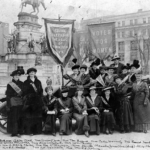International Women’s Day has been commemorated across the world on March 8th since 1911 and every U.S. President has marked March as Women’s History Month since 1995. While the right to vote is a common topic of study in classrooms when examining women’s history, there are many more issues, perspectives, and accomplishments that require investigation across history, literature, and the arts to more fully appreciate and understand what women’s history in the U.S. encompasses. Our Teacher’s Guide provides compelling questions, lesson activities, resources for teaching about the intersection of place and history, and multimedia resources to integrate women’s perspectives and experiences throughout the school year.
U.S. Courts: Women’s History Month
The federal courts observe Women’s History Month by celebrating women’s education and accomplishments. Find inspiring profiles of women who made federal court history and inspired others to succeed and watch first-person videos of contemporary women who serve on the federal bench today.
A Teacher’s Guide for Women’s History
The 116th U.S Congress that began its two-year session in January 2019 is historic for a few reasons. The Speaker of the House, Nancy Pelosi, is not only the first woman to hold the position, but also is the first person to return to the Speaker’s office in the House since Sam Rayburn in 1955. On another historical note, 102 women were elected to the House of Representatives and 25 serve in the Senate — the most women ever elected to Congress. With next year marking one hundred years since ratification of the 19th Amendment, this Women’s History Month is about more than just looking back. In this resource, find a list of compelling questions, student activities, and resources and lesson ideas.
Women’s History Month Lesson Plans & Resources

The Share My Lesson team has curated a collection of free preK-12 lesson plans and class activities for educators to use in order to incorporate key figures and historical events into their Women’s History Month lesson planning. This Share My Lesson collection spans topics like women’s suffrage and women’s rights and features influential women in science, social justice and sports.
Women & the American Story: A Nation Divided, 1832-1877
This free curriculum unit from the New-York Historical Society delves into the ways women participated in all aspects of the Civil War and on both sides of the conflict, from the early debate over the expansion of slavery through the end of federal Reconstruction. Materials examine this pivotal moment in American history through the experiences of diverse women and consider how the war and then Reconstruction policies shaped their lives.
Women’s Suffrage and Equal Rights: Lesson Plans and Resources

On August 18, 1920, the 19th Amendment to the United State Constitution was ratified, thus granting women the right to vote. The ratification of this amendment was a result of the powerful, unwavering momentum of hundreds of women who first convened a women’s rights convention in Seneca Falls, New York. This collection provides free lessons that will help students learn more about this important time in history, highlighting important developments in not only Women’s Rights, but U.S. Civil Rights and other amendments to the Constitution.
Who Were the Foremothers of the Women’s Suffrage and Equality Movements?
This lesson looks at the women’s suffrage movement that grew out of the failing of the Continental Congress by “remembering the ladies” who are too often overlooked when teaching about the “foremothers” of the movements for suffrage and women’s equality in U.S. history. Grounded in the critical inquiry question “Who’s missing?” and in the interest of bringing more perspectives to whom the suffrage movement included, this resource will help to ensure that students learn about some of the lesser-known activists who, like Elizabeth Cady Stanton, Lucretia Mott, and Susan B. Anthony, participated in the formative years of the women’s rights movement.
Evaluating the New Departure Strategy in the Fight for Women’s Suffrage
In this activity, students will evaluate the New Departure strategy of the women’s suffrage movement – the idea that the Constitution already guaranteed the right to vote for women, they just had to test it by voting – that was championed by the National Woman Suffrage Association. Students will analyze documents from Susan B. Anthony’s arrest and trial for voting in the 1872 election. They will answer questions as they work through the documents and evaluate the claim that the Fourteenth Amendment enfranchised women.
Women’s Contributions in the Civil War
In this lesson, students will view videos to visit Civil War-related sites in Alexandria, Va., where women worked as nurses, sold goods to soldiers and aided communities of newly-freed slaves.
From Suffragist Sashes to Antiwar Armbands
In a 19th Amendment video, produced by the Administrative Office of the U.S. Courts for use in classrooms, courtrooms, and the distance-learning space, an unlikely connection is made between two rights activists from different eras. Suffragette Virginia Minor and Vietnam war protester Mary Beth Tinker were separated by 100 years, but their passions came together in the legal history of the nation and of St. Louis, where they each worked through the courts to make social change. Both cases were decided – with different outcomes – by the Supreme Court of the United States.